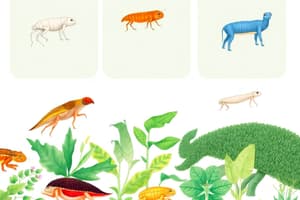Podcast
Questions and Answers
Alin sa mga sumusunod ang HINDI itinuturing na katangian ng mga buhay na bagay?
Alin sa mga sumusunod ang HINDI itinuturing na katangian ng mga buhay na bagay?
- Paglaki
- Homeostasis
- Metabolismo
- Pagkawala ng mga elemento (correct)
Ano ang tawag sa sistemang nagkakaisa sa mga buhay na bagay batay sa kanilang ugnayan sa pagbabago?
Ano ang tawag sa sistemang nagkakaisa sa mga buhay na bagay batay sa kanilang ugnayan sa pagbabago?
- Klasipikasyong Ebolusiyon
- Binomial na Klasipikasyon
- Klasipikasyong Linnaeus
- Klasipikasyong Cladistic (correct)
Alin sa mga sumusunod ang HINDI matatagpuan sa mga buhay na bagay?
Alin sa mga sumusunod ang HINDI matatagpuan sa mga buhay na bagay?
- Paglaki
- Pagtalikod sa mga stimulus (correct)
- Metabolismo
- Pagkilos sa paligid
Ano ang tawag sa sistemang nagkakaisa sa mga buhay na bagay gamit ang dalawang pangalan: genus at species?
Ano ang tawag sa sistemang nagkakaisa sa mga buhay na bagay gamit ang dalawang pangalan: genus at species?
Alin sa mga sumusunod ang HINDI katangian ng mga buhay na bagay?
Alin sa mga sumusunod ang HINDI katangian ng mga buhay na bagay?
Ano ang tawag sa mga bagay na hindi buhay na kasama sa isang ekosistema?
Ano ang tawag sa mga bagay na hindi buhay na kasama sa isang ekosistema?
Ano ang pinakamahalagang katangian na nagbubukod sa mga buhay na bagay sa mga di-buhay?
Ano ang pinakamahalagang katangian na nagbubukod sa mga buhay na bagay sa mga di-buhay?
Ano ang tawag sa proseso kung saan ang mga buhay na bagay ay naglilipat ng pagkain sa enerhiya, paglago, at pagkukumpuni?
Ano ang tawag sa proseso kung saan ang mga buhay na bagay ay naglilipat ng pagkain sa enerhiya, paglago, at pagkukumpuni?
Ano ang pinakamahalagang batayan sa pagkategorya ng mga buhay na bagay?
Ano ang pinakamahalagang batayan sa pagkategorya ng mga buhay na bagay?
Sa anong kategoryang biolohikal ang tao ay nakakategorya?
Sa anong kategoryang biolohikal ang tao ay nakakategorya?
Ano ang pinakamahalagang pagkakaiba sa pagitan ng mga buhay at di-buhay na bagay?
Ano ang pinakamahalagang pagkakaiba sa pagitan ng mga buhay at di-buhay na bagay?
Aling isa sa mga sumusunod ang halimbawa ng isang buhay na bagay?
Aling isa sa mga sumusunod ang halimbawa ng isang buhay na bagay?
Study Notes
Living organisms, also known as biotic factors, have several unique characteristics and play vital roles in ecosystems. Understanding these distinctions helps us differentiate them from their non-biological counterparts, which are classified as abiotic factors. Let's delve into the details of this fascinating area.
Characteristics of Living Things
Living organisms share certain common traits that set them apart from non-living entities:
- Growth: They increase in size through the uptake of nutrients and energy sources.
- Homeostasis: They maintain a stable internal environment despite external changes.
- Metabolism: Living organisms consume resources, convert them into energy, and expel waste products.
- Response to Stimuli: They react to their surroundings through physiological processes.
- Reproduction: They create offspring to continue their species.
- Decomposition: Dead living organisms break down over time, returning nutrients to the ecosystem.
Classification of Living Things
Biologists classify living things based on shared characteristics and evolutionary relationships. Two main classification systems exist:
- Binomial Classification: Developed by Carl Linnaeus, this system categorizes species using two names: genus and species.
- Evolutionary Systematics (Cladistics): This approach groups organisms based on shared evolutionary history.
Both systems aim to provide accurate and comprehensive descriptions of all living things on Earth.
Differences Between Living and Non-Living Things
Although similarities do exist, certain distinctions set living organisms apart from non-living entities:
- Growth vs. Physical Changes: While some materials undergo physical changes or transformations, only living things grow through uptake of nutrients.
- Cellular Organization: Living organisms consist of complex cells that carry out specialized functions.
- Metabolic Activity: Metabolism is the process of converting food into energy, growth, and repair. Only living things engage in metabolism.
Examples of Living Organisms
Examples of living organisms range from microorganisms such as bacteria and viruses to multicellular lifeforms like plants, animals, and fungi. For instance, humans belong to the kingdom Animalia, phylum Chordata, class Mammalia, order Primates, family Hominidae, genus Homo, and species Homo sapiens.
In conclusion, understanding the characteristics, classification, differences, and examples of living organisms provides valuable insights into the natural world and helps us appreciate the beauty of our planet's diverse lifeforms.
Studying That Suits You
Use AI to generate personalized quizzes and flashcards to suit your learning preferences.
Description
Alamin ang mga kaibahan at katangian ng mga biyolohikal na bagay mula sa kanilang mga hindi-buhay na katapat. Tuklasin ang mga pangunahing katangian ng mga organismo gaya ng paglaki, homeostasis, metabolismo, reaksyon sa stimuli, reproduksyon, at pagkausad. Alamin din ang mga sistema sa klasipikasyon ng mga organismo at mga halimbawa ng mga ito sa iba't ibang kaharian.




